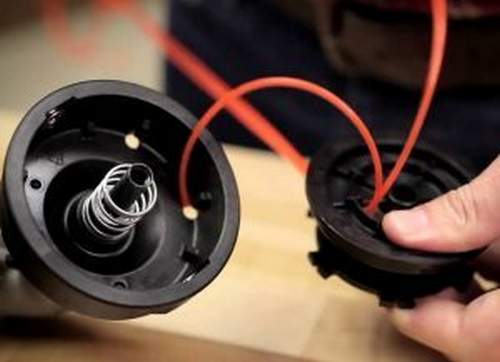A gasoline or electric trimmer is an indispensable assistant in the arsenal of a modern summer resident or the owner of his own house.

Thanks to these garden devices, you can easily mow down even a large garden plot. After acquiring this tool and doing a few tricks, many people think about how to wrap the fishing line on the trimmer coil correctly. For an inexperienced user, the first operation to replace it will seem problematic and time-consuming, since developers often do not fully reflect the instructions for replacing the fishing line in the instruction manual.
Preparation for winding fishing line
Prior to the winding process, it is necessary to remove the reel with fishing line from the housing. Depending on the manufacturer, power and type (electric or gasoline), there are three structural types of trimmers:
-
Compact electric trimmers.
Straight Bar Trimmer
In such a model, it is possible to install a knife. Removing the coil in such models is done by means of two keys recessed into the coil body. To install the trimmer knife, it is necessary to combine the hole of the bobbin and the rod, and then insert the device in the form of a steel pin (screwdriver, iron bar). After fixing the coil, it is easy to unscrew the housing by hand clockwise.
Winding fishing line on trimmer
The measured and accurate dismantling of the spool from the spit reel makes it possible to go directly to the winding of the fishing line. The design features of the head, the number and location of the fixing holes dictate the sequence of actions when performing this operation, and also determine the methods used. Today, there are several varieties of coils, depending on the number of antenna line fishing line and methods for refueling it:
Video: Winding Fishing Line On Trim Head
- Trimmer head with one working antennae;
- Reel fishing line with two antennae;
- Auto winding reel.
Single-Barrel Trimmer Coil
Single-mustache lawn mowing coil
Many owners and specialists note the simplicity of operation and refueling reels with one mustache. Depending on the manufacturer, the length of the fishing line can vary from 2 to 5 meters. The end of the line is inserted into the head in a special technological groove or hole, and winding is made in the direction opposite to the working rotation of the bobbin. Most coils on the outside of the case have marks in the form of arrows that indicate the direction of movement of the trimmer bobbin.
After winding, you need to leave a free end of 15-30 cm to enhance the centrifugal force, which is crucial when removing the trimmer line in automatic and semi-automatic reels. Pass the left end through the working hole of the coil and assemble the head.
Double Antenna Trimmer
Two groove head
After removing the spool from the coil body, we determine the number of streams for winding fishing line (1 or 2). There is no fundamental difference between the reels with one and two grooves, but with careless refueling in the twin groove, there are problems with operation. In view of the likelihood of weaving adjacent tool strings, a situation may arise when it is impossible to remove new ones after wear of the working antennae.
Regardless of the number of streams for refueling, a fishing line from 1.5 to 3 meters long is taken. Winding must be done in the direction opposite to the rotation of the head, since winding in the direction of travel will cause the line to not be removed from the reel. After the fishing line is tucked into the trimmer coil, free ends (15-30 cm) are threaded through special holes. Next, we collect the head in the reverse disassembly order and check the performance. Do not worry if the ends of the two antennae are very different in size, because when you start the trimmer, the knife installed on the guard will cut off the excess.
Trimmer head with automatic threading
Types of Trimmer Heads
In some models on the market set reel with automatic winding mechanism. It is enough for the owner to correctly fill and fix the ends in the head, and the tool itself will perform the winding operation when it is switched on in the operating mode. It is almost impossible to wind a fishing line into a trimmer with such a head, since the coil independently determines the position of the antennae. The advantages of the automatic trimmer head include the ease of refueling the fishing line, and the disadvantages are frequent breakdowns of the mechanism due to the complexity of the design and high cost.